Without a doubt, bees are very important insect pollinators and provide huge benefits to our ecosystem. Although many people are scared of a bee sting, these beneficial insects have very interesting characteristics.
To start with, bees have five eyes, and they see flowers very differently compared to us humans.
Why do bees have 5 eyes? Bees have 5 eyes because they need them for their daily activities. Bees use their two compound eyes for viewing different kinds of movements. The remaining three simple eyes of bees are very effective in detecting sunlight and ultraviolet patterns, so they can easily find flower nectar.
Bees don’t have excellent eyesight as compared to humans. However, their five eyes have superpowers that people don’t have.
Bees don’t only use their eyes during pollination; they also use them to protect themselves. If you want to learn more about bee eyes, this article has a lot of very important facts about them.
Table of Contents
Do All Bees Have 5 Eyes?
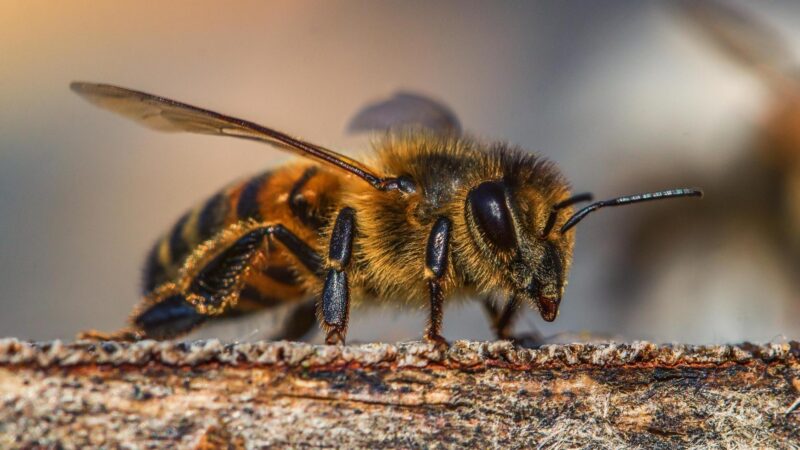
All bees have 5 eyes, which are very useful for them. This visual ability of bees makes them very adaptable to different tasks and difficult situations.
Most bee species have better eyesight during the day. Interestingly, some insects also have five eyes. This includes dragonflies, flies, grasshoppers, and wasps.
Do Bees Have Hair on Their Eyes?
Bees have hair on their eyes. In general, bees have microscopic hair (setae) all over their head, thorax, and abdomen.
All bee species also have very tiny hairs around and even on the surface of their compound eyes. The purpose of these spaced hairs is to prevent pollen from getting stuck directly to the eye.
Using their hairy forelegs, honey bees can easily remove the pollen from their eyes with the help of the hair on their eyes.
According to a study, honey bees transfer the pollen to their hind legs and then back to their hive. If they don’t groom their eyes properly, it will be very hard for them to pollinate efficiently.
What Does a Bee’s Eye Look Like?
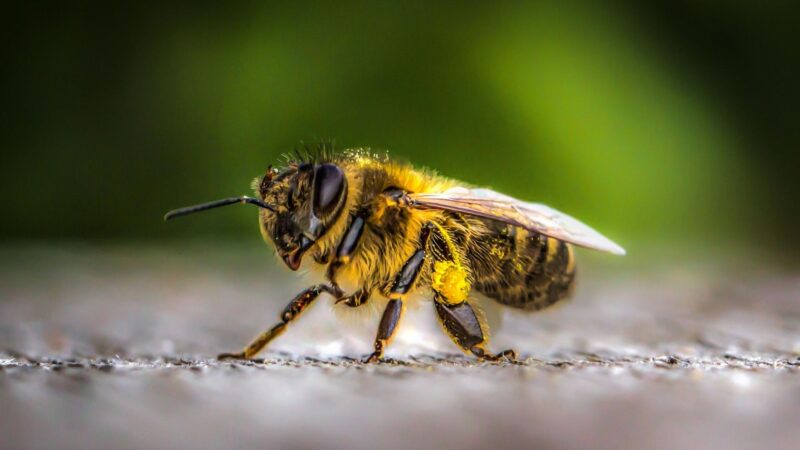
A bee’s eyes are almost the same as the eyes of some insects, such as grasshoppers and dragonflies. These insects have two compound eyes that are too big and very obvious.
They can easily be seen on each side of a bee’s head. A single compound eye of a bee is a mosaic of thousands of hexagonal faces.
Bees also have three simple eyes that look like small dots. Each of them has a single lens only. Nonetheless, these eyes are not as simple as many people would think.
Simple eyes may not be as complex as compound eyes, but they have several sensory cells that help bees a lot in detecting various movements.
What Are Bee Eyes Called?
Bees have two different sets of eyes – two compound eyes and three simple eyes called ocelli. These five eyes allow bees to enjoy very remarkable eyesight.
Bee’s eyes work very differently from human eyes. For example, honey bees and bumblebees see images based on the edges, but they cannot see all colors.
Do Honey Bees Have Compound Eyes?
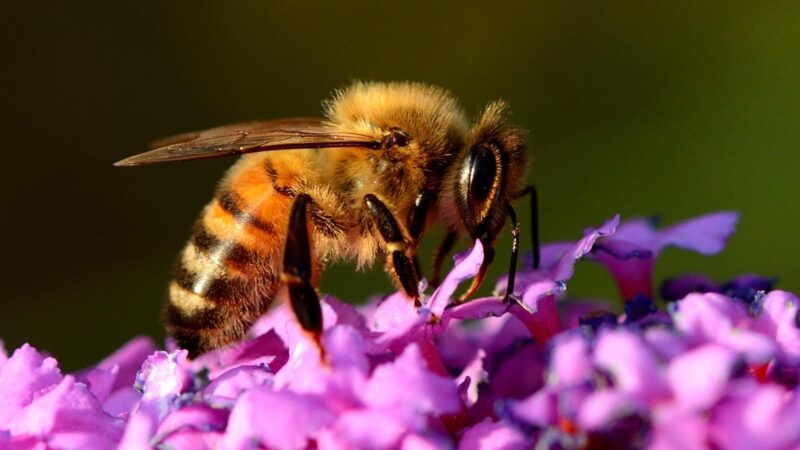
Honeybees have two compound eyes. Each of them is located on the opposite side of their head. They are composed of tons of ommatidia or so-called micro eyes that are fused together.
Every ommatidium has a nerve connection and a light-sensitive lens, which helps bees see things differently.
What Is Special About Bee Eyes?
Unlike human eyes, bee eyes are very special when it comes to looking at images. Aside from three simple eyes, bees have two compound eyes that are made of thousands of ommatidium.
Each of these ommatidia has a hexagonal face called facet, which has eight photoreceptor cells that can distinguish colors.
Technically, the lowest human visual acuity is much higher than the maximum visual acuity of bees. This means that bees can hardly distinguish between objects, particularly at far distances.
Since compound eyes have a larger field of vision as compared to human eyes, all bee species are considered near-sighted.
On the other hand, bees can see images but not like the way humans see them. Bees cannot clearly see the outlines and definitions of an image, which means that their eyes have very low resolution.
Unlike humans, bees find it difficult to distinguish objects in 2D form. But amazingly, they can recognize objects in 3D.
Interestingly, bees can also recognize polarized light or light waves that move in one direction only. This amazing ability of bees to scan polarization patterns acts as their GPS or navigation system.
Therefore, bees can still identify their exact location even if there is not enough sunlight, helping them to return home easily.
But more importantly, the bee’s simple eyes have the ability to see UV light. Although we cannot see it, flower petals have UV patterns that serve as visual aids for bees to see them.
Therefore, bees can easily target the nectar without a miss. Without this skill, bees will lose interest in pollinating flowers and may die.
Where Are a Bee’s Eyes Located?
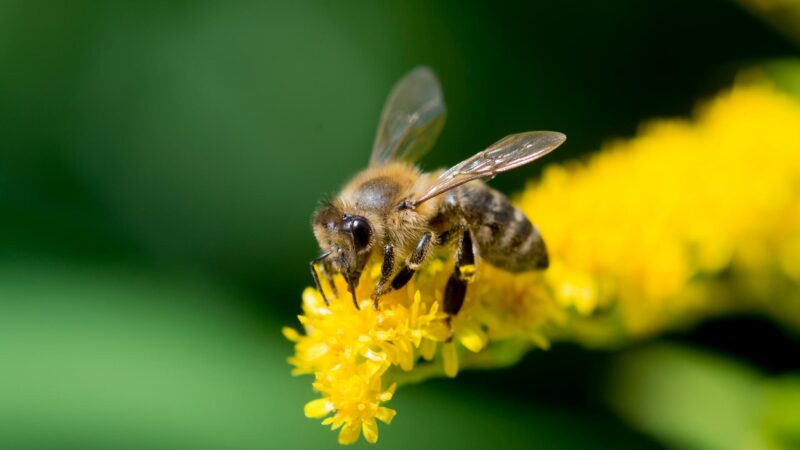
As mentioned earlier, the pair of bee’s compound eyes are located on either side of the head. In fact, these eyes are too large and almost cover their heads.
On the other hand, the three smaller eyes are arranged in a triangular form and are located at the top of their head. These eyes are almost invisible to the naked eye.
What Color Are Bee’s Eyes?
Most bees have black eyes, including honey bees and bumblebees. However, some bee species have different eye colors. For example, silver leafcutter bees and male carpenter bees have pale green eyes.
Meanwhile, some species of Anthophoridae bees have green eyes, while others have gray or dark purple eyes.
Can Bees See Color?
Bees can see colors but not the same way people do. As humans, we can see light in wavelengths between 390 and 750 nanometers (nm).
On the other hand, bees can see lights 300 to 650 nm, which means that they cannot see red. Therefore, these insects can view in the ultraviolet spectrum while humans don’t.
Bees can also distinguish between gray, black, and white, which makes them great at identifying different kinds of shapes.
But according to a study, bees are not interested in black and white. Instead, they use the strongest signal to identify a shape. Hence, bees see edges very clearly but can hardly see circles and ovals.
Do Honey Bees See Moving Objects Better?
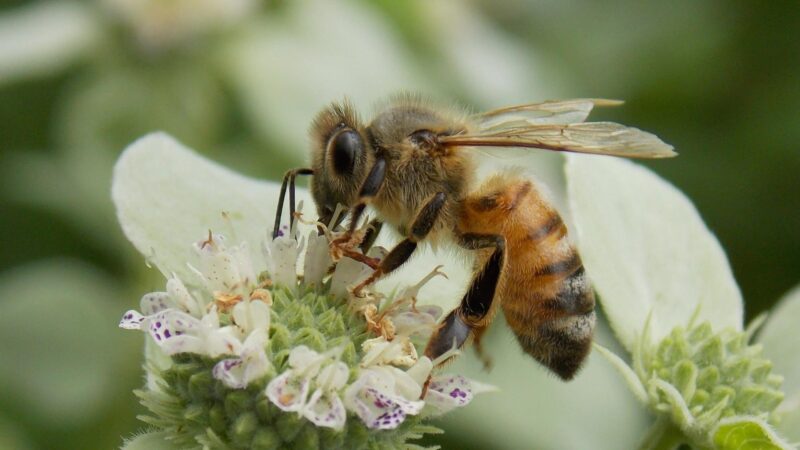
Honey bees see moving objects better. This sophisticated skill of bees is due to their ability to view objects even while flying at a higher speed.
In fact, bees can sense movements separated by 1/300th of a second. Comparatively, humans can only perceive movements separated by 1/50th of a second.
According to a study, scientists concluded that bees see colors nearly five times faster than humans. It also turns out that bumblebees have the fastest color vision among all animals.
Because of this, bees can quickly avoid bee swatters and fast-approaching flying predators, making them better pollinators.
Can Bees See at Night?
Most bees cannot see at night since their eyes are unable to see a dim light. This is also probably why bees are generally diurnal, which means they are most active in the day and rest at night.
In a viral video, bees in a laboratory can be seen falling dramatically and have stopped flying once the lights were turned off.
But according to research, some honey bee species can also see clearly at night. Apparently, researchers in Sweden and Germany have concluded that these bees might have used some image processing tricks to improve their poor night vision. But then, some bee species can see at night with less effort.
Unknown to many, some sweat bees such as Megalopta atra, Central American sweat bee (Megalopta genalis), Indian carpenter bees (Xylocopa latipes), and halictid bees (Augochlorini) are considered nocturnal bees.
This is because they can see even during the darkest hours of the night without the help of moonlight.
Among the other bee species that have been observed to have a night-time foraging behavior include masked bees (Meroglossa gemmata) and nomiine bees (Reepenia bituberculata).
These Australian bees have enlarged compound eyes and simple eyes as compared to diurnal bees, allowing them to see in the dark.
Aside from that, some bee species are crepuscular, which means they are most active during twilight.
This includes the mountain carpenter bee (Xylocopa tabaniformis), a genus of large squash bees (Xenoglossa fulva), and the feather-tongued bee (Ptiloglossa arizonensis). These bees are common in tropical areas.
Summary
Understanding how bees see things can help us a lot in treating them better. Since they have a wider range of color vision as compared to us, technology experts can use bees to study how to improve camera performance navigation systems. After all, bees serve as one of nature’s gifts that we should learn from.
List of Sources
Bee-hold: The Eye of a Honey Bee
Honey Bee Hairs and Pollenkitt Are Essential for Pollen Capture and Removal